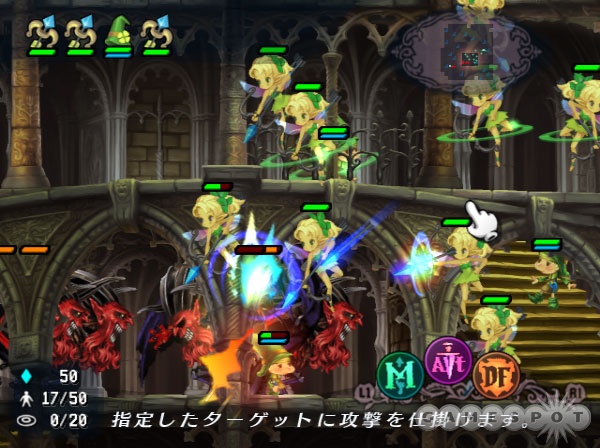GrimGrimoire Updated Hands-On
We spend some quality time with an English-language build of NIS America's upcoming fantasy real-time strategy game.
Currently scheduled for release in North America in June, GrimGrimoire is a real-time strategy game that's unusual not only because it's appearing on the PlayStation 2, but also because it employs a lateral rather than a top-down camera perspective. We were afforded a small taste of GrimGrimoire's storyline and gameplay at NIS America's event in San Francisco last month, so when we received our own copy earlier this week, we jumped right into the game.
GrimGrimoire takes place in a fantasy world where elves and fairies are real, key characters share their names with alcoholic beverages, and magic rather than science accounts for much of the school curriculum. You'll assume the role of Lillet Blan, a talented young student who has recently been admitted to the prestigious Tower of Silver Star magic academy. The game's story is told entirely through noninteractive cutscenes that take the form of conversations between characters with such inebriating names as Gammel Dore, Bartido Ballantine, Margarita Frozen, and Chartreuse Grande. The relationships between these characters are worthy of the trashiest soap opera, but before you have a chance to get too engrossed in their interactions, they all vanish, and it's down to you as the only person left in the tower to figure out what happened to them. But you won't really be alone because the only way for you to solve the mystery is to relive your first five days at the school (just before everyone disappeared) over and over again.
As intriguing as the storyline is, its relevance to GrimGrimoire's actual gameplay appears to be largely nonexistent. Each "day" in the game comprises a slice of real-time strategy action sandwiched between two story scenes, but none of the story characters ever appear during combat, and Lillet is only present onscreen as a disembodied hand cursor. Bizarre storyline and 2D-platformer-style visuals aside, GrimGrimoire is fairly conventional as far as real-time strategy games go. Your first five days at the Tower of Silver Star will be spent playing through tutorial missions that introduce you to such concepts as resource gathering, unit construction, enemy attacks, and base defenses. The most unusual thing about GrimGrimoire is that the battlegrounds are all areas within the tower, where the only geographical features you need to concern yourself with are staircases, broken floorboards, impassable pillars, and the crystals that you'll be mining for mana.
Mana is the only resource in GrimGrimoire, and you'll need plenty of it to perform just about every action that's available to you. The types of summoning runes (think of them as your bases), familiars (units), and defensive structures that are available to you will be determined by how many of the game's 12 spell books (or grimoires) you've collected. The first school of magic that you'll learn to use is "glamour," which gives you the power to summon and control elves, fairies, and unicorns. As you progress through the game, you'll also master the arts of necromancy (ghosts, phantoms), sorcery (imps, demons, dragons), and alchemy (blobs, golems, chimeras). These four magical disciplines share a rochambeaulike relationship, and the abilities the units afford you are varied enough that you'll rarely want to stick with just one discipline in levels where you have the option to use two or three. For example, glamour familiars have to negotiate their way around obstacles, while such astral beings as ghosts and phantoms can pass right through them. Some familiars are immune to certain types of attack as well, so, as in most RTS games, you'll find that sending the right units to do the right job is key.

Based on what we've played thus far, GrimGrimoire's learning curve is quite steep. The tutorial missions walk you through everything with so much detail that they verge on being patronizing. After completing those missions, you're thrown in at the deep end with new units to figure out and far more powerful enemies to battle. Respite comes in the form of three difficulty settings that can be altered for each level, but if you're anything like us, you'll be reluctant to switch down from "normal" to the setting labeled "easy," let alone the even less challenging "sweet" mode. In some of the tougher levels, the challenge isn't necessarily that you need to employ any clever strategies, but rather that you need to try to move around the map quickly and make sense of skirmishes in which multiple unit sprites (some of them taking up a sizable portion of the screen when using the default camera) are overlapping and obscuring each other. The default camera, while close enough to show off the aforementioned sprites to good effect, isn't a viable option during gameplay. So the first thing you'll want to do is zoom out as far as the game allows and get a feel for your surroundings.
Many of the levels that we played through ended up being won (not always by us) using the fantasy equivalent of a "tank rush" maneuver. It'll be interesting to see if anyone needs to get more creative as the game progresses and units with more varied abilities are added to your arsenal. We look forward to bringing you more information on GrimGrimoire as soon as it becomes available.
Got a news tip or want to contact us directly? Email news@gamespot.com
Join the conversation